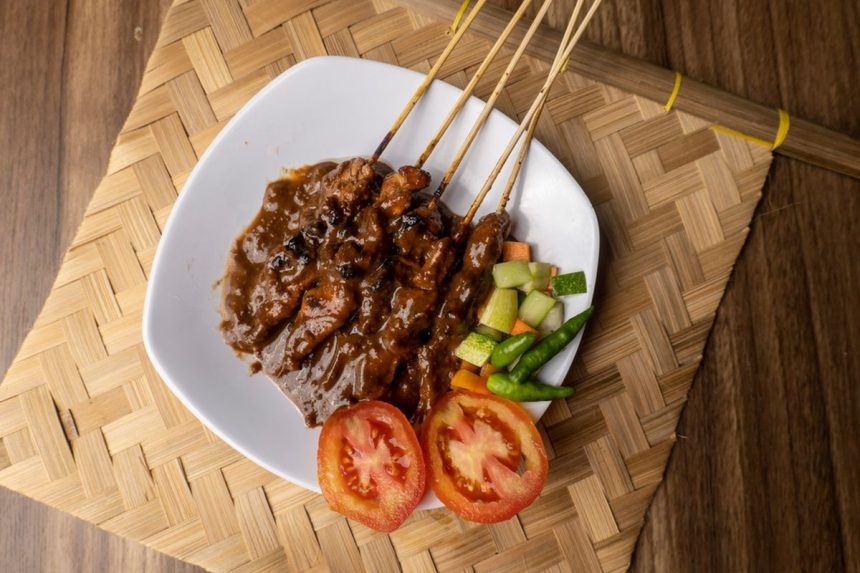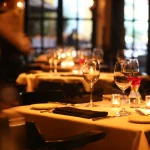Liga Asuransi – Reader friends, how are you? May you, your family and your business always run smoothly. Amen. On this blog, we always talk about risk and insurance to protect your business. This time, we discuss the risks faced by soto and satay restaurants, two traditional culinary delights that are increasingly popular with many people. If you find this article useful, share it with your colleagues. Don’t forget to check out hundreds of other interesting articles here!
Imagine a satay stall that is always busy with customers and is a favorite in the area. However, one day a fire broke out in the kitchen due to a short circuit in the gas stove. This incident not only damaged cooking utensils and kitchen parts, but also forced the shop to close temporarily, causing loss of income. In another case, a customer filed a claim after experiencing food poisoning due to unhygienic raw materials. Without protection, risks like these can devastate traditional restaurant businesses.
Traditional restaurants, such as soto, satay or nasi uduk stalls, are the backbone of Indonesian culinary delights that offer distinctive flavors and are the main choice for many people. However, this business faces various local restaurant risks, ranging from fires, damage to cooking equipment, to customer claims. With so many operational challenges, business owners need strategic steps to protect their businesses.
One effective way to manage restaurant operational risks is to have the right insurance. The cost of insurance premiums for traditional restaurants is relatively affordable, only around 0.5%-1% of the asset value or annual turnover. With this small investment, business owners can get culinary business protection that covers property damage, legal liability, and operational disruption.
This article is designed to help traditional restaurant owners understand the risks they face and how insurance can be an effective protection solution. Don’t let risks stop your business from moving forward—let’s learn more about how to protect your traditional restaurant with the right insurance!
Uniqueness and Challenges of Traditional Restaurants
Traditional restaurants are an important part of Indonesia’s culinary identity. With a distinctive menu that reflects the richness of regional culture, this restaurant is not only a place to eat, but also a means of preserving the culinary traditions of the archipelago. However, behind its uniqueness, traditional restaurants also face various challenges that can threaten business sustainability.
- The Uniqueness of Traditional Restaurants
Iconic Menu
This traditional restaurant is famous for its typical dishes such as soto ayam, goat satay, curry, nasi uduk, and various other traditional menus. Each dish has a unique taste using typical Indonesian spices. This iconic menu is the main attraction and the reason customers keep coming back. Soto with warm sauce or satay with the aroma of charcoal grilling always succeeds in creating nostalgia and satisfying customers’ palates.
Operational Characteristics
One of the unique things about traditional restaurants is the way they cook, which still maintains traditional techniques. The process of cooking large portions of soto sauce for hours or grilling satay with charcoal is something that is not easy to find in modern restaurants. However, this method also makes restaurant operations more complex and requires extra attention to ensure food safety and quality.
Loyal Customer
Traditional restaurants usually have a loyal local customer base. These customers often come not only to enjoy the food, but also because of an emotional attachment to the restaurant. They feel part of the community built by the restaurant, thereby supporting business continuity through regular visits.
- Traditional Restaurant Challenges
Kitchen Fire Risk
Traditional cooking processes such as using charcoal and high-pressure gas stoves increase the potential for fires in the kitchen. A satay stall, for example, uses a charcoal grill that produces an open fire. If not monitored properly, this fire can cause a costly fire. This risk requires serious attention to maintain operational safety.
Customer Claims
Traditional restaurants also face the risk of customer claims due to unhygienic food or certain food allergies. For example, if raw materials such as meat or coconut milk are not stored properly, the food can become contaminated and cause poisoning. Additionally, some customers may have allergies to ingredients such as nuts or certain spices, which could give rise to legal claims if not clearly stated.
Cooking Equipment Damage
Large cooking equipment such as pots, pans, or grills are often key assets in traditional restaurant operations. Intensive use every day makes these tools susceptible to damage. Without adequate equipment, the cooking process can stop, disrupting service and causing lost income.
Supply Disruption
Traditional restaurants rely heavily on fresh ingredients such as meat, vegetables and spices. Price increases or shortages of certain ingredients, such as chilies during certain seasons, can have a major impact on a restaurant’s operations and profits. This challenge requires a careful supply management strategy to ensure restaurants can continue to meet customer demand.
Key Risks Facing Local Restaurants
Local restaurants, such as soto, satay or nasi uduk stalls, are an important part of Indonesia’s culinary ecosystem. Even though it is the backbone of the traditional food industry, this business is not free from various risks that can threaten business continuity. Below are some of the main risks that local restaurants often face and their impact on operations.
- Risk of Fire and Property Damage
Reason:
Fire is one of the biggest risks local restaurants face. The cause can come from an electrical short circuit due to inadequate installation, staff negligence when operating cooking equipment, or the use of traditional cooking equipment such as charcoal grills and gas stoves.
Impact:
Fires can cause major damage to buildings, decorations, and major cooking equipment such as large pots and pans. Additionally, fires often require restaurants to close temporarily for repairs, meaning lost revenue. Restaurant owners who do not have protection, such as insurance, must bear all repair costs themselves, which can reach tens to hundreds of millions of rupiah.
- Legal Risks and Customer Claims
Example:
Food poisoning is one of the frequent customer claims at local restaurants. This can be caused by raw materials that are not fresh or lack of attention to cleanliness during the serving process. Additionally, customer injuries, such as slipping on slippery floors or unsafe furniture, can also result in lawsuits.
Impact:
Customer claims not only result in financial losses, but can also damage a restaurant’s reputation. Dissatisfied customers tend to spread their negative experiences, which can reduce public trust in your business. Without public liability insurance coverage, compensation costs and legal fees can be a huge burden for business owners.
- Financial Risk
Loss of Income:
Disasters such as fire or flood can cause restaurants to close temporarily. This closure means a loss of daily income, while the owner still has to pay fixed costs such as rent and employee salaries.
Equipment Replacement Cost:
Local restaurants often rely on traditional cooking equipment such as large pots, grills, or gas ovens. Intensive use every day makes these tools vulnerable to damage. The costs to replace or repair these devices can be enormous, especially if they fail simultaneously. Without insurance coverage, these financial burdens can disrupt a business’s cash flow.
- External Risks
Supply Chain Disruptions:
Local restaurants rely heavily on supplies of fresh ingredients such as meat, vegetables, charcoal and spices. Disruptions in the supply chain, such as increases in meat prices during times of high demand or shortages of certain ingredients, can impact restaurant operations.
Decreasing Consumer Purchasing Power:
Unstable economic conditions, such as inflation or a decline in people’s purchasing power, can have a direct impact on the restaurant business. Consumers will likely reduce their spending on eating out, meaning decreased revenue for local restaurants.
The Right Type of Insurance for Traditional Restaurants
Traditional restaurants, such as soto, satay or nasi uduk stalls, face risks that can threaten business sustainability. To protect your business from various threats such as fire, customer claims, or operational disruptions, having the appropriate type of insurance is a wise step. Here are some types of insurance that are right for traditional restaurants and their benefits for your business.
Functions and Benefits
Property insurance provides protection against damage to buildings, kitchen equipment and restaurant interiors due to fire, flood, earthquake or other disasters. Traditional restaurants often use large cooking equipment such as pots, pans and grills, which are important investments in daily operations.
Sample case:
Imagine a soto shop that experiences a kitchen fire due to an electrical short circuit in the gas stove. The resulting damage included kitchen walls, cooking utensils and food supplies. Without property insurance, restaurant owners must bear all repair and replacement costs themselves, which can reach tens of millions of rupiah. With insurance, these losses can be covered by the insurance company, so the restaurant can return to operation quickly.
Functions and Benefits
Public liability insurance protects restaurants from legal claims brought by customers due to losses they experience, such as food poisoning or injuries on the restaurant premises. Traditional restaurants often serve large numbers of customers every day, so the risk of these incidents is quite high.
Sample case:
A customer slipped on the slippery restaurant floor and was injured. The customer then submitted a claim for medical expenses. In other cases, customers experienced allergic reactions due to foods containing nuts without clear information. With public liability insurance, restaurants can cover compensation costs and
- Insurance with Affordable Premiums
Functions and Benefits
One of the main advantages of insurance for traditional restaurants is flexibility in determining premiums. Premium costs can be adjusted to the restaurant’s needs and financial capabilities. Generally, insurance premiums for small restaurants range between 0.5%-1% of the total asset value or annual turnover.
Sample case:
A nasi uduk stall with total assets worth IDR 200 million only needs to pay a premium of around IDR 1 million to IDR 2 million per year to get full protection for property, public liability and other operational risks. This small investment provides a big guarantee for business continuity.
Insurance Premium Cost Factors for Local Restaurants
One important consideration for local restaurant owners before purchasing insurance is the cost of premiums. Understanding the factors that influence premiums and how to adjust them to your business budget is a strategic step to get optimal protection without burdening your business finances. The following is an explanation of what influences the cost of insurance premiums, the benefits of paying them, and how to adjust them to business needs.
- What Affects Premiums?
Some of the main factors that influence the cost of insurance premiums for local restaurants are:
Value of Restaurant Property and Equipment
Restaurants that have large assets, such as their own building, decorative interiors, and premium cooking equipment, tend to have higher premiums. This is because the replacement value of the asset is greater if damage occurs.
Types of Risks Insured
The type of protection chosen also affects the premium. Protection against fire, legal claims or equipment damage has different levels of risk calculated into the premium. The more risk coverage included, the higher the premium that must be paid.
Restaurant Location
The location of the restaurant greatly influences the cost of the premium. Restaurants located in areas prone to flooding or fire will be subject to higher premiums due to the greater risk. On the other hand, restaurants in low-risk locations usually have more affordable premiums.
- Benefits of Paying Insurance Premiums
Many local restaurant owners hesitate to allocate funds for insurance premiums because they consider it an additional expense. However, insurance is actually a small investment to protect large values.
- Protecting Business Assets:
By paying a small premium, such as IDR 5 million per year, a satay stall can be protected from major losses due to fire which can reach tens of millions of rupiah.
- Reducing Financial Stress:
When a risk occurs, such as a customer claim or damage to cooking equipment, insurance can cover these costs so that the owner does not need to spend sudden funds that could disrupt business cash flow.
- Maintaining Business Continuity:
With insurance, businesses can continue to run even if they face major risks, such as losses due to natural disasters or other operational disruptions.
- How to Adjust Premiums to Budget
For local restaurant owners who want affordable coverage, here are some ways to fit insurance premiums into your budget:
- Choose Insurance Coverage that Suits Your Needs
Not all risks need to be insured. Restaurant owners can choose the coverage most relevant to their business needs, such as fire protection and customer legal liability.
- Consult an Insurance Broker
Insurance brokers have expertise in understanding the unique needs of local restaurants and can help you find the best insurance plan with affordable premiums. They can also help negotiate premiums that fit your budget without reducing the scope of coverage.
- Accurately evaluate asset values
Avoid paying exorbitant premiums by accurately assessing the value of restaurant assets. Ensure that the insured amount reflects the actual needs of the business.
The cost of insurance premiums for local restaurants is influenced by factors such as the value of the asset, the type of risk being insured, and the location of the restaurant. Even though it requires budget allocation, paying insurance premiums is an important investment to protect your assets and business continuity. With the help of an insurance broker, you can adjust coverage and premiums to suit your budget without sacrificing protection. Don’t let unexpected risks threaten your culinary business—make sure your restaurant is protected with the right insurance!
Why Choose Insurance Broker Services for Traditional Restaurants?
Traditional restaurants, such as soto, satay or nasi uduk stalls, face various operational risks that can threaten business continuity. From fire risks to customer claims, every risk requires proper protection. This is where insurance broker services play an important role to ensure your traditional restaurant gets maximum protection at an efficient cost. Here are the reasons why choosing an insurance broker is the best decision:
- Special Skills
Insurance brokers have a deep understanding of the unique needs of traditional restaurants. They understand specific risks such as damage to traditional cooking utensils, the risk of fire due to the use of charcoal or gas stoves, as well as challenges such as customer claims regarding unhygienic food. With this expertise, a broker can help you choose the insurance products that are most relevant to your business needs.
- Best Product Selection
Brokers have access to a variety of insurance products from various companies. This allows them to compare the benefits, coverage, and premiums of each product to find the best solution for your business. Whether you need protection against property damage, public liability, or other business risks, a broker can put together a package that best suits your needs.
- Premium Negotiation
One of the big advantages of using a broker is their ability to negotiate more competitive premiums. With their extensive network and experience in the industry, brokers can help you get maximum protection at an affordable cost. This is especially important for traditional restaurant owners who want to keep budgets under control without sacrificing patronage.
- Claim Assistance
If an incident occurs, such as a fire or customer claim, the insurance claims process often takes time and effort. An insurance broker will accompany you throughout the claims process, from collecting documents to communicating with the insurance company. With this assistance, your claim will be processed more quickly and efficiently, so you can focus on business recovery.
Insurance broker services provide significant added value for traditional restaurant owners. From understanding specific risks to assisting with claims, brokers ensure you get the best protection at a cost that fits your budget. Don’t let unexpected risks threaten your culinary business—choose an insurance broker for professional and trusted protection solutions!
Conclusion
Traditional restaurants are an important part of Indonesia’s culinary riches. With typical dishes such as soto, satay, curry, and uduk rice, these restaurants not only serve delicious food but also maintain culinary traditions that have existed for many years. However, like other businesses, traditional restaurants face risks that can threaten business continuity, ranging from operational risks such as fire and damage to cooking equipment, to legal claims from customers and financial disruption due to disasters.
Having the right insurance is an important step to protect traditional restaurants from these risks. Traditional restaurant insurance offers comprehensive coverage for property, public liability, business interruption, and food products, so you can focus on running your business without worrying about unexpected threats. With affordable premium costs, only around 0.5%-1% of the asset value or annual turnover, insurance is a small investment with big benefits.
Protect your traditional restaurant now! Contact L&G Insurance Brokers for a free consultation and find the best protection solution for your local culinary business. Our professional team will help you choose insurance products that suit your business needs and budget, as well as provide full assistance during the claims process.
Don’t let risks hinder the development of your business. Contact us now and ensure your traditional restaurant is ready to face any challenge with the right insurance protection. With insurance, you can run your business with peace of mind and focus on success!
Looking for insurance products? Don’t waste your time and contact us now
HOTLINE L&G 24 JAM: 0811-8507-773 (CALL – WHATSAPP – SMS)
Website: lngrisk.co.id
Email: oktoyar.meli@lngrisk.co.id
—















